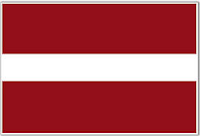One of the first economic news of this 2014 year is Latvia joining the Eurozone on January, 1. The Eurozone, i.e., the European countries sharing the Euro as a currency, now comprises eighteen member states which are: Austria, Belgium, Cyprus, Estonia, Finland, France, Germany, Greece, Ireland, Italy, Latvia, Luxemburg, Malta, Netherlands, Portugal, Slovakia, Slovenia, and Spain. When the Euro was introduced in 1999, only eleven countries adopted it. Currently, ten other countries of the European Union (EU), including the United Kingdom (UK), have not yet adopted the Euro. The UK is still protective of its national currency, the very expensive Pound Sterling.
Since the New Year's day, surfing on the Net, frequent questions one comes across are: what is Latvia known for, where is its location... Myself I have wanted to know more about this country and its economy.
Latvia was formerly part of the Union of Soviet Socialist Republics and became independent on November 8, 1991. It joined the EU in 2004. It covers an area of 64 589 km2 (24 938 square miles) and is bordered to the North by Estonia, to the South by, Lithuania, to the East by Russia, to the Southeast by Belarus, and to the West by the Baltic Sea. The capital city of this Eastern European country is Riga. The declining population of Latvia was estimated at 2 023 825 in 2013. Its people as well as its language are called Latvian. Some natural resources abounding in Latvia are: limestone for cement, gypsum, high-quality clay, dolomite, amber, and timber.
Latvia is one of the fast growing European countries. It experienced two digit growth rates between 2005 and 2007 and terribly suffered from the global recession of 2008-2012. Its real gross domestic product (GDP) fell by 17.7% in 2009. It has recovered since 2011 when it showed a growth rate of 5.3% while advanced Eurozone countries such as France and Germany were exhibiting respectively a growth rate of 2% and 3.3%. Its forecast growth rate and GDP for this year are respectively 4.1% and 14 941.8 millions of euro.
Latvia experienced an average unemployment rate of 12.07% during the first three quarters of 2013, an average slightly higher than that of France, which was 10.9%, but far below the unemployment rate of Greece and Spain, which were above 20%.
When Latvia joined the EU in 2004, its inflation rate, which was 2.9% the previous year, jumped to 6.2% to reach the peak of 15.3% in 2008. Inflation was curbed and brought to 2.3% in 2012.
The trade balance of Latvia is adverse, i.e., it imports more goods and services from the rest of world than it exports. In 2006, its imports grew by 19.6% while its exports only grew by 6.4%.
On the New Year's Eve, the US dollar/Euro exchange rate was 1.379. On January 2, the value of one euro was 1.366 dollars. On January 3, this exchange rate was 1.363. This slight depreciation of the Euro (-.2%) can be attributable to an increase in the supply of the Euro induced by the entry of Latvia in the Eurozone.
Note that on the day before its entry into the Eurozone, the Latvian currency, the Lats, was worth 1.42 Euros.
When Latvia joined the EU in 2004, its inflation rate, which was 2.9% the previous year, jumped to 6.2% to reach the peak of 15.3% in 2008. Inflation was curbed and brought to 2.3% in 2012.
The trade balance of Latvia is adverse, i.e., it imports more goods and services from the rest of world than it exports. In 2006, its imports grew by 19.6% while its exports only grew by 6.4%.
On the New Year's Eve, the US dollar/Euro exchange rate was 1.379. On January 2, the value of one euro was 1.366 dollars. On January 3, this exchange rate was 1.363. This slight depreciation of the Euro (-.2%) can be attributable to an increase in the supply of the Euro induced by the entry of Latvia in the Eurozone.
Note that on the day before its entry into the Eurozone, the Latvian currency, the Lats, was worth 1.42 Euros.


No comments:
Post a Comment